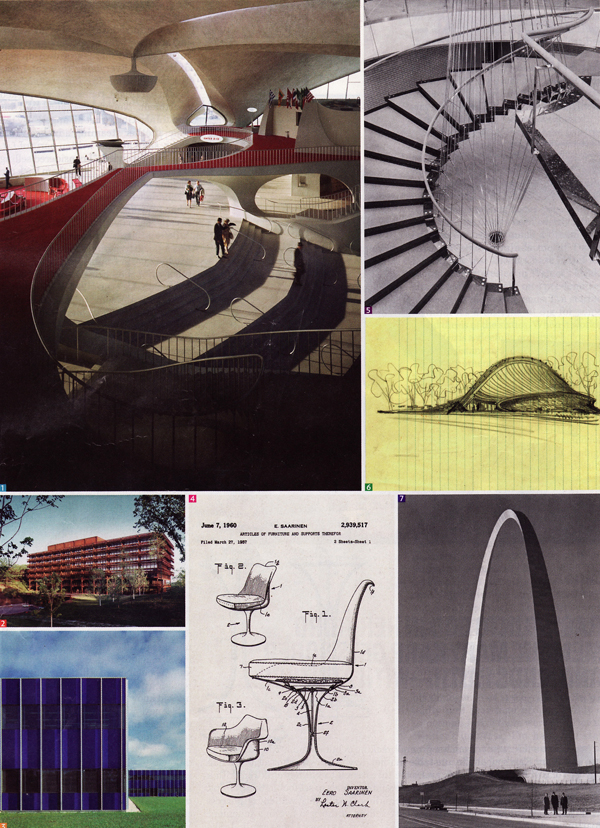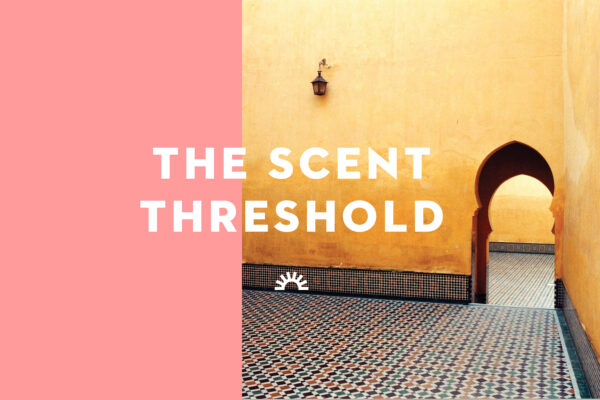Saarinen and the curve
In this week’s New York magazine, Justin Davidson has a review of the new Eero Saarinen show at the Museum of the City of New York (a wonderful place, so if you’ve never had the opportunity to visit, this might be a good chance). The title of Davidson’s review is “Joy Constructed,” so of course this caught my eye and started me thinking that perhaps Saarinen might represent a counterpoint to the hard-edged, rationalist, emotionally-muted modernism represented by the Bauhaus and the International Style — a truly joyful modernist.
Looking at the swooping railings, ceilings, staircases, and arches in the spread above (from New York magazine), I can’t help but feel uplifted. But why? I’ve previously suggested that curves and round forms have a primal appeal because they are connected with safety. As children we are naturally drawn to objects with non-threatening surfaces, and the more broad and neutral the curve, the more safe and approachable an object is. (No one’s going to cut themselves on a beach ball.)
As it turns out, there’s science to support this idea. In a 2007 study published in the journal Neuropsychologia, researchers demonstrated that angular objects and shapes are perceived as significantly more threatening by the emotional brain. Showing curved and angular variants of the same object (a watch, a pitcher, a candle) and abstract patterns to a group of volunteers resulted in markedly different activity in a part of the brain called the amygdala, which is involved in threat and fear reactions and responds far more quickly than the conscious brain. Angular objects create much more activity in this part of the brain than curved objects. This makes sense in the context of survival within a primitive world — sharp angles are rare in nature, and usually do signal danger, or at least something we should be alert to: teeth, claws, cliff edges, and so on.
Human nature is a funny thing. You can build upon it, channel it, develop it to its greatest potential, but you can’t fight it. I look at the rigid rectilinear solids of modernist construction and I think of them as an attempt to put human nature in a box. To suppress these innate responses. But the unconscious elements within us react whether or not we want them to — they are uncontainable. In thinking of Saarinen, along with Zeisel and Aalto and other modernists who embraced the curve, I see a modernism that runs along the contours of our natural inclinations, an aesthetic that is conducive to joy.
Joy isn’t rational, and it seems fitting that Saarinen would say of his water tower design for GM (below) that it “is a departure from the completely rational.” It’s an unexpected admission for a modernist, and yet a fitting one for a designer who, in Davidson’s words, was spurred on by, “the dogged pursuit of joy.”






Discussion (3 Comments)
Good article, but how about some references? “In a 2007 study published in the journal Neuropsychologia…” …and that’s it? Aren’t you writing a book on this, and don’t we still provide citations in books? Nothing wrong with some old fashioned means of following up.
Thanks for your comment, Tim. You’re right – it was a little bit of laziness on my part not to provide a reference. Here it is:
Bar, Moshe and Maital Neta. Visual elements of subjective preference modulate amygdala activation. Neuropsychologia 45 (2007) 2191-2200.
Link:
http://www.sciencedirect.com/science?_ob=ArticleURL&_udi=B6T0D-4N7S5BD-2&_user=10&_coverDate=12%2F31%2F2007&_rdoc=1&_fmt=high&_orig=search&_sort=d&_docanchor=&view=c&_searchStrId=1207821538&_rerunOrigin=google&_acct=C000050221&_version=1&_urlVersion=0&_userid=10&md5=c2e18c7ec567a83f55c540a317aa9a91
Enjoy!
Another famous modernist architect you might look into is the Brazilian Oscar Niemeyer. Loved curves and color.